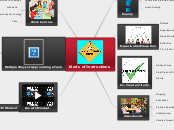TIPS
Core Concepts of Collaborative Inquiry
Why do Teachers Use Collaborative Inquiry?
Collaborative Inquiry allows teachers to work together to identify problems that they are noticing within their classrooms and teaching methods. Together, teachers identify, analyze and test out alternative instructional methods (based on new evidence found through inquiry) so that they can teach every student to the best of their ability.
Here is a video that shows teachers during
collaborative inquiry. These teachers are
identifying problems in their teaching instruction,
sharing ideas and working together to find
ways to better teach their students.
This video was recommended by Dr. Reeve
for PME 801, and I wanted to include this in my concept map because I found it very useful in understanding
the Lesson Study process and collaborative inquiry
in general.
8 Steps to Collaborative Inquiry
Collaborative Inquiry Framework
1. Identify the Problem (Frame)
Work together to identify the problem(s) at hand.
Be a problem solver, not positional.
Be open-minded and mindful of any biases you may have that may hinder your collaborative process and progress.
2. Plan
Work together as a group to devise a plan/strategies to approach the problem/task at hand.
Ask: What strategies will you use to implement your plan? As with lesson planning, think about the task at hand and decide together what kind of changes you want to make. Who will implement the changes? What will be the timeline? What outcomes are you looking for, etc.?
Be organized and concise about how you will approach your plan. Clearly communicate with other members of the group to ensure you are all on the same page.
3. Act
Implement the strategies planned by your group.
Ensure you are carrying out the original plan set out by group.
Remember the importance of differentiated instruction in the classroom.
4. Collect Data
Determine how you will record changes from previous instructional strategies.
Be sure to make observations throughout the whole process.
7. Debrief
Debrief with group collaborators about findings.
Explain what worked. What didn't work. What next steps can be taken, etc.
Share ideas, thoughts, theories about findings.
5. Analyze Data
Reflect on data.
What seemed to work? What didn't?
6. Document
Document findings.
Determine next steps.
8. Celebrate!
Celebrate your groups accomplishments and
encourage future collaboration! :)
What is Collaborative Inquiry?
"Through collaborative inquiry, teachers integrate new knowledge and understanding of student learning and classroom instruction into their existing knowledge of professional practice." - Ontario Ministry of Education, Capacity Building Series #16.
Collaborative Inquiry allows teachers to reflect and refine teaching methods that have previous proved to be unsuccessful so that they can expand their knowledge as teachers to ensure that their teaching instruction is meeting the needs of students.
https://www.edu.gov.on.ca/eng/literacynumeracy/inspire/research/CBS_Collaborative_Teacher_Inquiry.pdf









